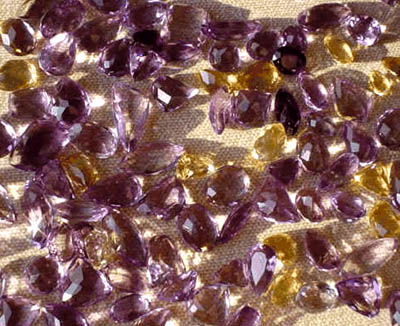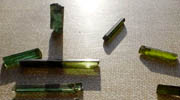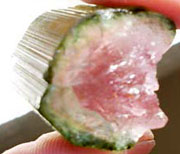Identification of rocks
The identification of stones is an alluring activity . There is a range of chemical and physical methods that can be applied to it, with various degrees of complexity.
refractive index
colour
Colour is perhaps the most basic way of identifying a stone. Below we see amethysts (purple) and citrines (yellow):

The density test can be very accurate and it is simple to perform. It is also simple from the theoretical point of view. The stone will have to float or sink when tested in liquids whose density is carefully determined .Organic solvents are often used. Bromoform (similar to chloroform but with a bromine in the place of a chlorine), for instance, is used in the identification of Topaz.
Another important technique consists of checking the grain sizes.
grain size: Depending on the conditions, large crystals cannot be formed, and small crystals are formed instead. Small crystals are known as grains . (petrography)
grain diameter (mm) |
grain classification |
<1 |
fine |
1-5 |
medium |
5-300 |
coarse |
>300 |
very coarse |
Sandstone is known to be a medium grained rock.
This test can be performed with the naked eye but a microscope is usually required.
Chemical tests : Those usually involve the use of different acids . We find that certain classes o stones dissolves in certain acids. The effervescence caused by a drop of hydrochloric acid in contact with limestone signs that a chemical reaction is taking place.
Hardness: The most expensive rocks are usually the hardest. Diamond is the hardest material on earth, followed by other gemstones like emerald and aquamarine.
A rock can always be scratched by a hardest one, and that provides a very simple test. Look how ordinary glass can be easily scratched.
Texture is to do with the way in which the grains are arranged and their relative sizes.
Crystals and grains may be randomly arranged.
There are interlocking and non-interlocking textures.



